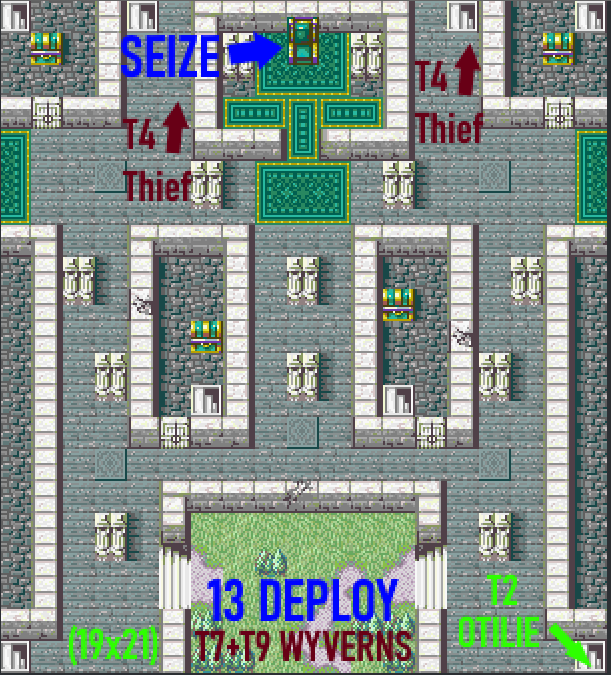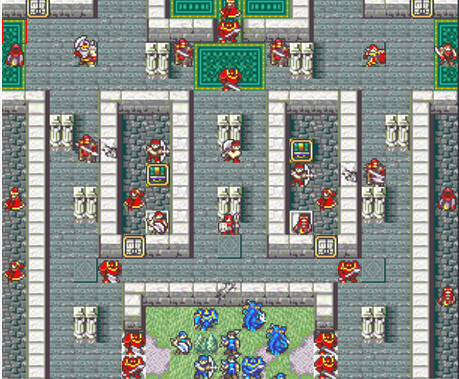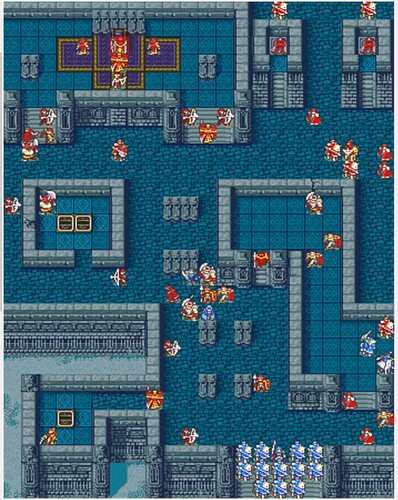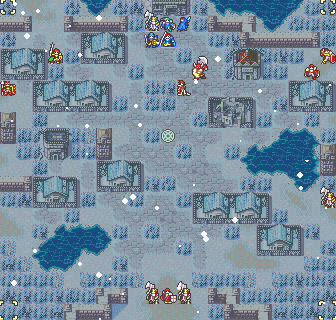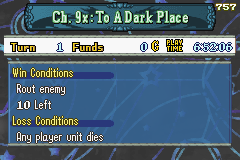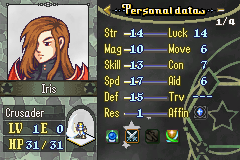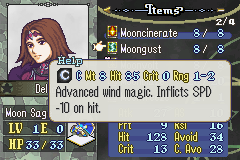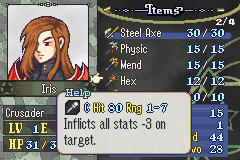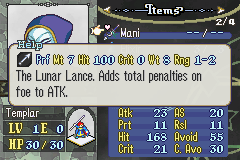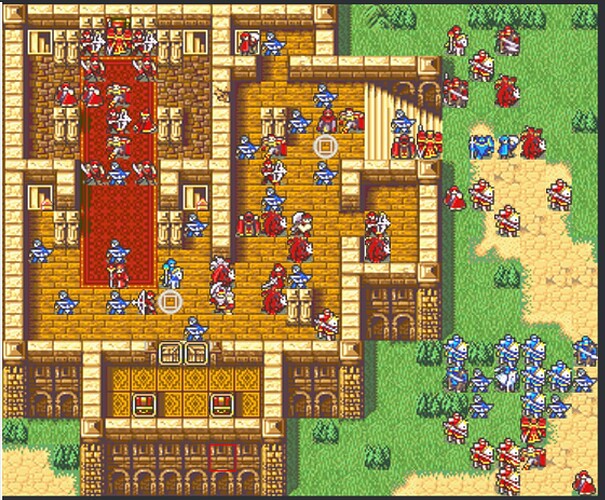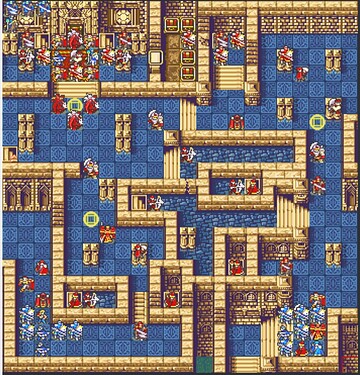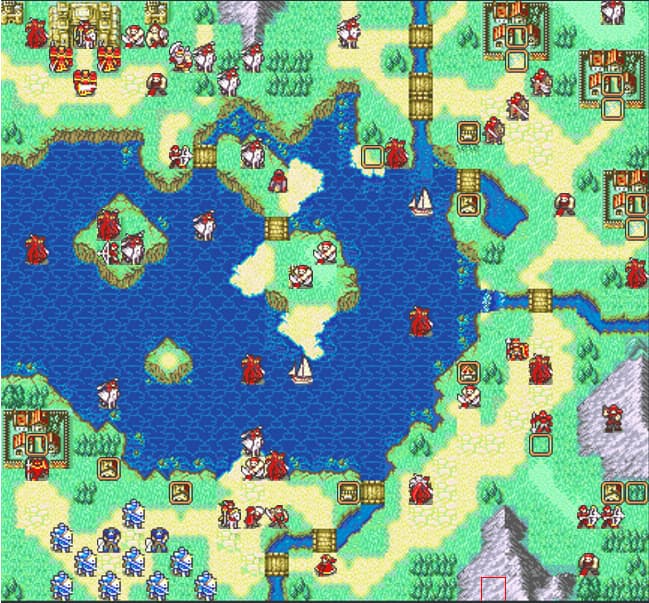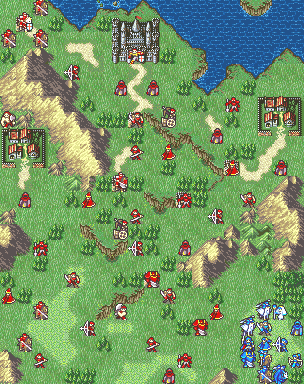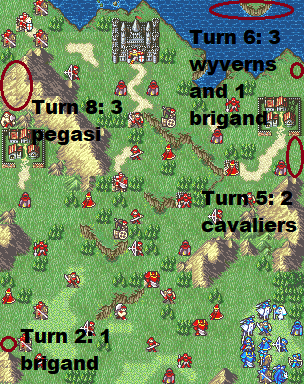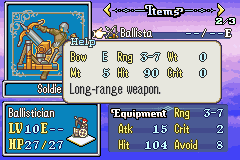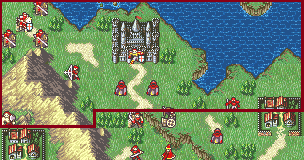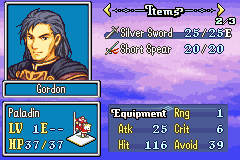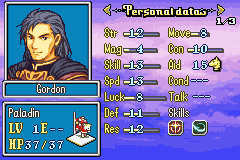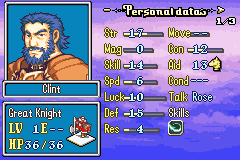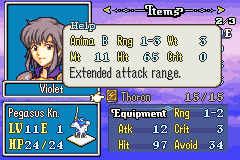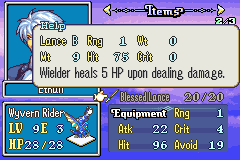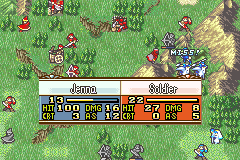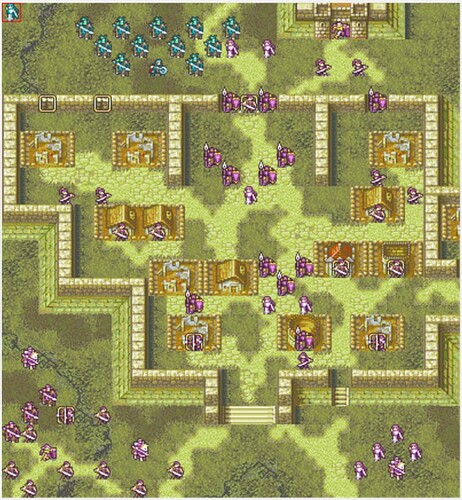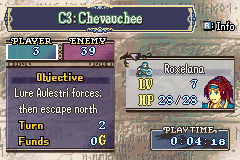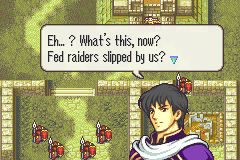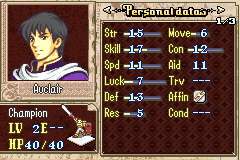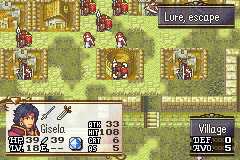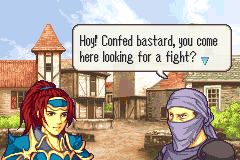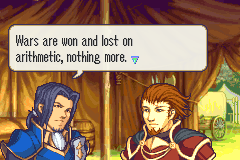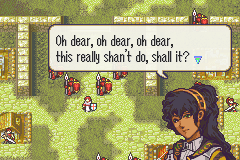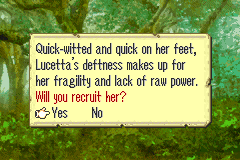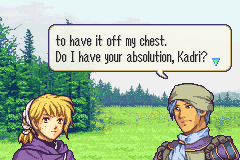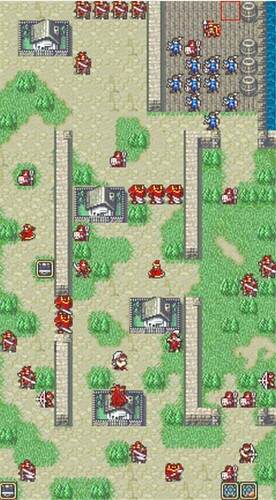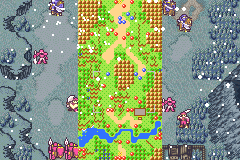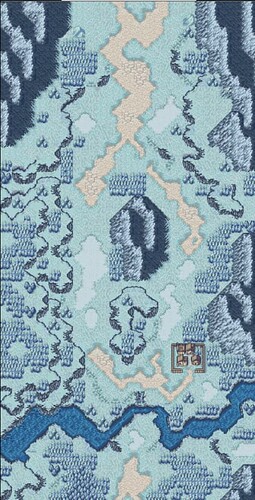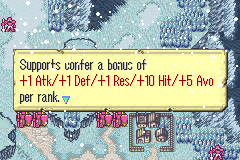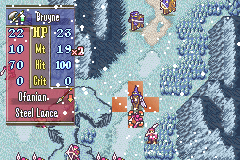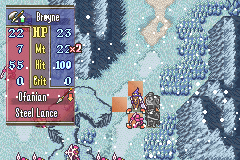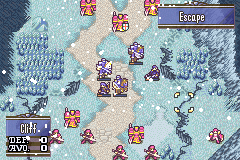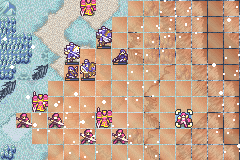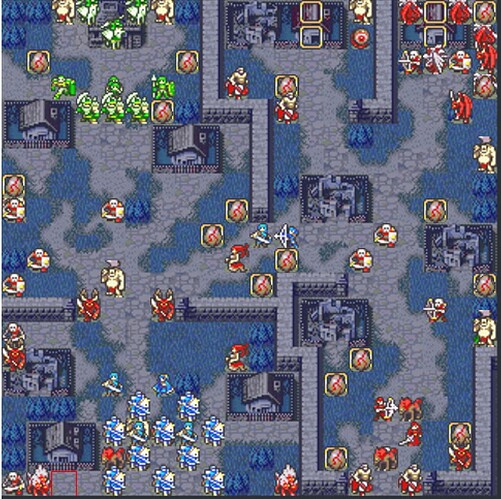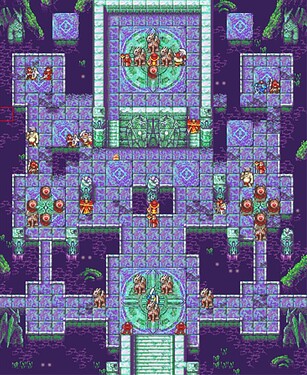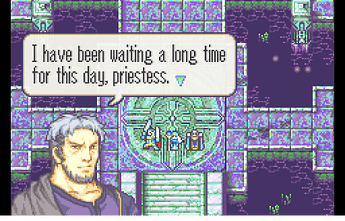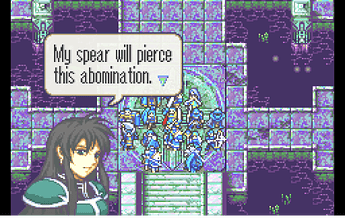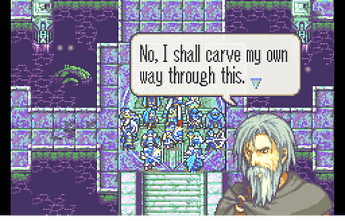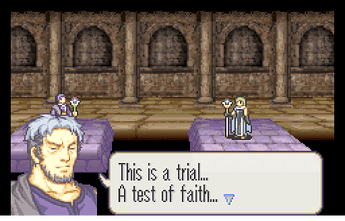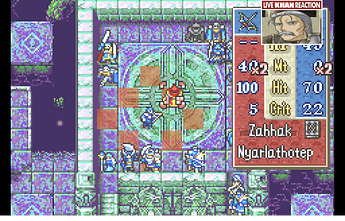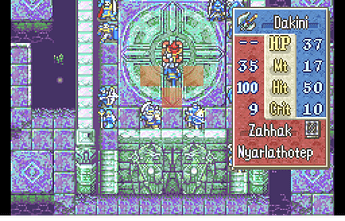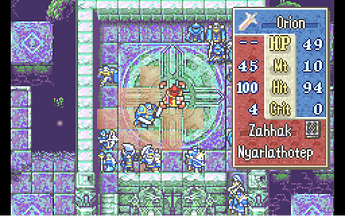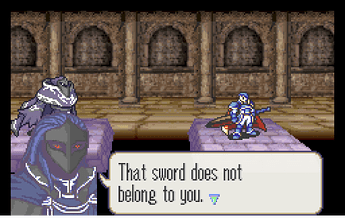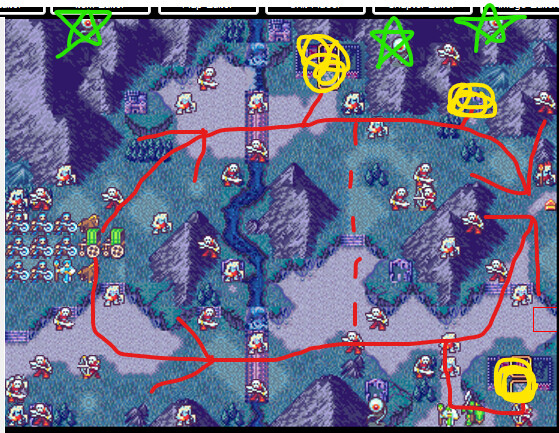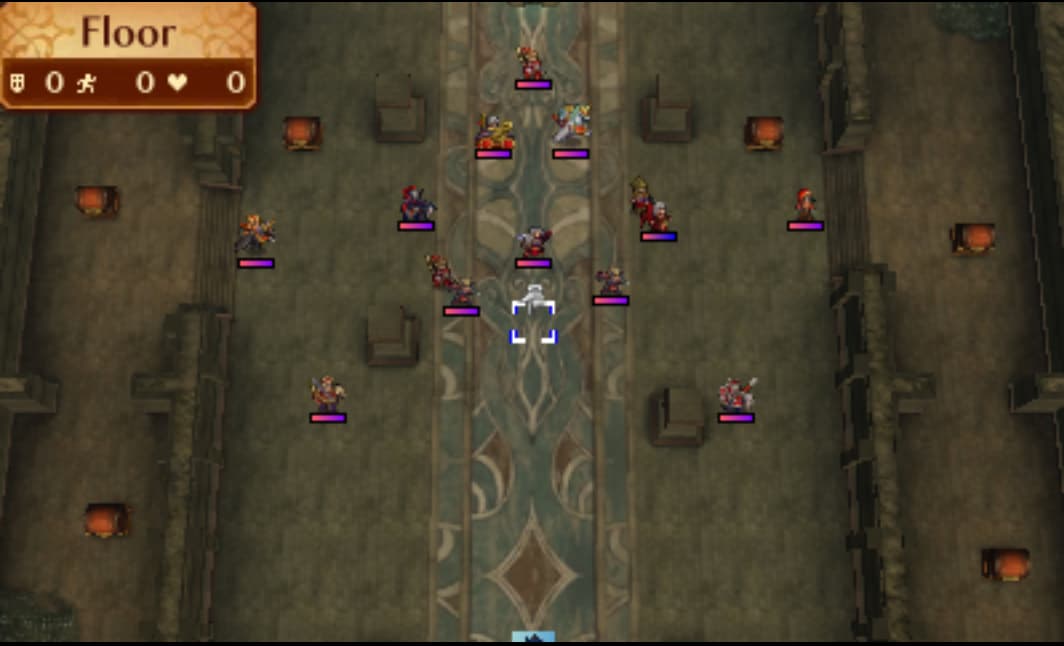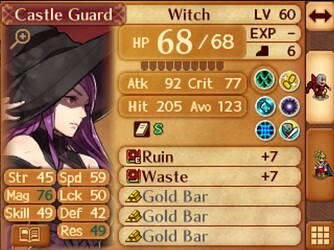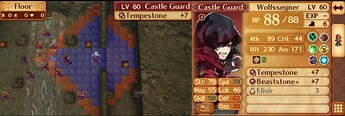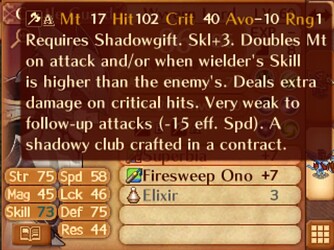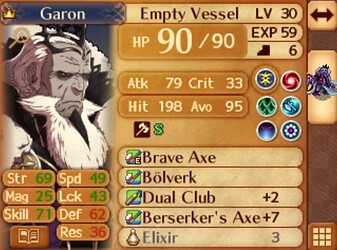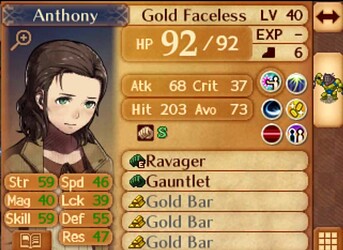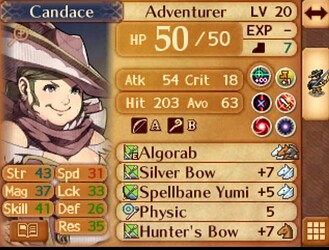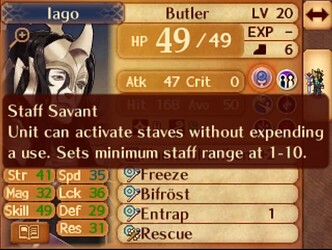It’s got a chunk of the game’s title in its name. So surely it must be good, right?
I can’t talk about this map in any way without spoiling enormous parts of the endgame lol
Part 1: Paint Me A Picture
The story context for the chapter is very much like what you’d see in a mainline FE game: the cult of Ahribaal has resurrected an ancient evil god known as Zahhak the Unspoken One, and the heroes have rushed down into his tomb to duke it out. Along the way, the group kills the ghosts of some of his followers, and the lord Orion slays the spirit of the Unspoken One’s most devout companion. He comments that something feels off about that particular spirit’s demeanor before taking his weapon, a profane blade, as his own.
As they reach the bottom of the tomb, the Unspoken One himself—along with the cult’s leader Gamliel—appears before the group… and the final showdown begins. The map itself is a ruined underground temple, the same tileset as FE8’s final map. And as the characters say their start-of-map final battle quotes one by one and the player begins issuing commands to their units, a GBA midi cover of Twilight of the Gods starts playing in the background. It sets up an atmosphere that is climactic in an acutely familiar way for anyone who’s played a couple Fire Emblem games before (in other words, almost anyone who’s ever touched a hack).
In terms of gameplay it’s a pretty grueling map, and for one big reason: the Unspoken One himself. True to the form of a literal god, the Unspoken One hits very hard and his defenses are impossibly high. It’s to the point where many of your units might be straight up useless against him, and the only hope of actually damaging him are the weapons that deal 3X effective damage to him: the legendary weapons that dragon priestess Freesia (basically the in-universe equivalent of Dragon Jesus) designed specifically to kill him. He is not a “fun” boss to fight in the traditional arcade/sportsy definition of the word.
Now, even I will admit that these defenses could’ve been toned down a teeny tiny bit, because even with the legendary weapons you’ll need units with high Strength/Mag in order to do any semblance of damage. Lance and bow users especially struggle as their legendary weapons have lower might than the other weapons. But I think it’s still a really cool and respectable element of the fight that helps it capture the vibe of a battle between god and mortal—accurately reflecting the narrative hype that the story has been building around the Unspoken One from the start. It forces you to put your most powerful tools and units on the table if you want a chance to land any meaningful hits at all, let alone win. And hell if that doesn’t capture the atmosphere of standing up to a deity far beyond your caliber. (It doesn’t matter anyways since it’s the last map, so you might as well quit hoarding and use all your legendary weapons)
In most scenarios, this kind of setup would immediately lead to a static slog in which your units huddle around a stationary boss chipping away at him. But this is not the case with Zahhak (at first): one turn after you get a hit in on him, he warps away to another part of the temple before summoning more monsters to throw at you. He does this multiple times throughout the chapter, which distinctly integrates him into the map’s formations and gives him lasting presence and influence on the map. It’s a really nice shift from the usual one-roundable bosses who often don’t feel like they have any impact on their maps, and it fits his story setup like a glove. It also meshes with his oppressive statline to create a very interesting gameplay effect where every hit you land on him feels like something you have to push for. Because of this, I found this stage of his fight to be strangely reminiscent of Shadow of the Colossus’s core gameplay loop, where every stab into a Colossus’s back takes a lot of effort and precision on the player’s part to pull off successfully… which in turn makes each stab feel more weighty and dramatic, as it should be when fighting a titan far above your weight class.
Most FE bosses last maybe one or two turns and then fizzle out in an embarrassingly anti-climactic manner. They are barely part of the map at all, more often than not. But thanks to his map’s mechanics, the Unspoken One is a lasting presence on the battlefield who you have to be extremely mindful of in order to avoid casualties. And while he eventually stops teleporting around after a while—admittedly a potential weakness in the execution, as it does devolve into a static slugfest at that point—I like the premise and core idea behind the mechanics enough that I’m still willing to talk about it here.
Part 2: Cracks in the Glass
There’s far more than just this to say about the chapter, though. As you progress through the waves of monsters and cultists, strange things start to pop up for those who have the eyes to search for them. It all begins with the cult leader, Gamliel: there’s a cutscene prior to the map where the Unspoken One remarks that the modern lexicon of facts has been rewritten into fiction, and he promises to tell Gamliel the true nature of the world.
And if you fight Gamliel with Freesia on the map, she can immediately see in his eyes that he is no longer certain of what the real truth is. He was always one of the most faithful and devout characters in the game, but whatever the Unspoken One told him offscreen has completely shattered his worldview. And seeing such a passionately pious man’s faith waver is a clear indication that something is going wrong.
Freesia: Ah, I see. You’ve put up a great front until now. But I see it. Your faith has faltered.
Gamliel: This is a trial… A test of faith… I’ve come so far… I will not lose heart in front of you, snake!
There’s a few more subtle clues, like the fact that some smaller plot threads have yet to be wrapped up, or the fact that you are still missing some of the legendary weapons. There’s even a clue on one of the images above that I didn’t mention, that you may have noticed! (I don’t think it was an intentional clue on the dev’s part, though it’s still something I noticed and found strange as a first-time player.) But it’s really the biggest development that ties the chapter’s concepts together into one cohesive image.
Remember how the Unspoken One can only be harmed through weapons that Freesia designed to kill him? Aside from the legendary weapons, there’s one more weapon that deals effective damage to him: the profane blade that the Unspoken One’s right hand man once wielded, which is now in Orion’s hands. In fact, it’s one of the more reliably effective weapons against him: the Patastra can often barely scratch him, the Nodens does absolutely nothing given its piss low Might, the Mada hits hard but has shaky hit rates and has a ~45% chance to whiff it, and the Dunbaalze’s weight means that its users are likely to get weighed down and doubled in retaliation in many cases. The profane blade avoids many of these problems, and while its mileage might vary depending on the quality of a given playthrough’s Orion, it often manages to chip away at the boss’s HP a reliable rate. Not only that, but it’s unbreakable too, for people who still stubbornly insist on hoarding weapon uses despite the fact that it’s the literal final map.
And while it’s technically not the BEST weapon for the job (that would be the Goldbrandt), you really want to get in as many hits in on the Unspoken One before he teleports away and spawns the next batch of monsters, and a “pretty reliable” option is as good as any.
This is all cool and good, but it also brings up another huge question: why would the Unspoken One’s most loyal follower be holding a weapon that would deal such harm to him, when the only weapons that can actually penetrate his defenses are Freesia’s weapons? Given that the legendary weapons are effective against him because Freesia explicitly designed them to slay him, the profane blade’s damage bonus comes off a bit odd… but there’s only one way to find out, isn’t there? There’s no better way to piece together the puzzle than to ask the man himself.
All these little elements have to be leading up to something big, right? Well, here’s where the cracks in the veil begin to show themselves: if Orion attacks the Unspoken One with the profane blade, the Unspoken One’s demeanor shifts completely from what it was like before. Gone is the steely, brooding “dark evil god” archetype that you’ve seen already in every FE, FE-like, and JRPG, replaced by an entity with very human emotions: rage, offense, and even a bit of hurt.
“That sword does not belong to you,” Zahhak tells Orion. “You will all die, but your death will be the most painful!”
This was a uniquely satisfying glimmer for me—possibly one of the most memorable narrative setups I’ve ever experienced in any work of interactive fiction. It felt like the mechanics of the map were tuned towards leveraging its gameplay and the gaps in its story to push me to use the profane blade against Zahhak, and in doing so it gently eased me into uncovering a huge breakthrough in the story. The effort it took to get into position to line up a successful hit against him, and the gravity and climax behind each combat with him as a result, also fed directly into this effect.
This whole setup cultivates a feeling of unraveling a clue to a mystery on your own—and this is an effect that’s more difficult to replicate with less interactive forms of presentation, like cutscenes. Of course, cutscene reveals can still bring about a reaction of shock, revelation, or “I knew it”… but weaving the discovery into the gameplay and locking it behind the player’s agency leans harder into the idea that you the player were the one to discover it. So when Orion starts to realize that things are starting to go off script from the usual fare, the audience understands how he feels just as well too.
Now, hiding vital story clues like this in missable stuff like a battle conversation would normally be a huge risk; after all, a player who misses this dialogue will lack an important piece of context for the beating heart of the story’s final act. But because completing 23-3 necessitates using a combination of the legendary weapons, with the profane blade often being the second most reliable option to fight Zahhak, it is quite unlikely that a player will miss it—so the feeling of “discovering” something vital is retained without the actual vital content being particularly easy to miss.
Part 3: Curtain Call
It’s beyond here where DLATMOL embraces its core identity and begins to divert hard from this tried-and-true trope by having its Medeus archetype receive some actual characterization beyond being a mysterious ancient evil god. Everything in this chapter, from the dialogue to the distinctly recognizable endgame BGM to the boss’s stats and oppressive presence on the map to the gameplay forcing you to use the legendary weapons to proceed at all, leans into familiar tropes to retain that classic “final map” vibe and make Zahhak come off like a very by-the-book endgame Medeus archetype. But through this gradual trickle of divergences in the formula that don’t quite add up, it slowly drifts apart from that all-too-familiar script until it’s suddenly incredibly apparent that there’s much more to Zahhak than meets the eye. All of this plants seeds that bloom in the last arc of the game, where all the newly unearthed and unanswered questions get answered and the things that didn’t add up suddenly do—and while I think that there are some parts of it that are more hit or miss (like the new villains), it also builds upon everything that’s established about Zahhak’s character in this chapter in a really splendid and memorable way, and I don’t think DLATMOL’s story would function properly without the chapters that come after this.
Oh, right. I forgot that I’d said this a moment ago…
Nowhere else in the game does this come out brighter than in Chapter 23-3—the game’s final chapter—which I find to be one of the most fascinating and engaging chapters I have ever seen in a romhack.
Yeah, I, uh. may have lied about it being the final chapter. If you read the above effortpost on DLATMOL 25, well… the existence of that chapter at all (and all chapters after 23-3) is technically a big spoiler. Chapter 23-3 is designed to come off like a final map in every way, down to having fake final map quotes for every character. And the fact that the game isn’t over yet is a big twist in of itself. sure, the hack post says that DLATMOL is 27 chapters, but that’s also easily interpreted as the 23 numbered chapters plus the 4 gaidens.
Either way, even if it’s definitely not perfect in a number of ways (I hear An Unexpected Caller tries to execute its mechanics in a more polished form, though I haven’t actually tried it myself) I really love this chapter, and I look forward to it whenever I give DLATMOL another go. It’s a testament to the critical importance of designing your maps in a way that is narratively engaging, and it’s a demonstration of how executing sufficiently engaging vibes can still make a chapter feel really fun and awesome to play even if it’s not necessarily in the traditional arcade-style sense of “fun”.
But while this chapter is cool and neat in a vacuum, it is also made significantly more interesting through the role it plays in the grander scheme of things. It serves as a foundation for Zahhak’s future characterization; the setup done here, and the sleight of hand regarding this “final” map, goes a long way in making the remainder of his writing function as crisply as it does. The fact that this isn’t the last map ultimately works to the game’s advantage as well, giving the story time to further flesh out Zahhak and thoroughly explore how he diverts from his archetypal first impression. And I couldn’t be happier about it: while I think his story is much more compelling seen with your own eyes than summarized on an effortpost, there is an argument that Zahhak the Unspoken One is one of the most memorable and ambitious characters I’ve seen in any romhack, and I think a lot of what makes him tick lies within the essence of this map.
Anyways, due to the inherently spoiler-heavy nature of this post, I honestly don’t think I would’ve written this post at all if the DLATMOL 25 effortpost wasn’t already in the thread. But if for some reason you’re reading this and haven’t picked up DLATMOL yet… know that there’s a fair number of other little details and puzzle pieces in this chapter that I deliberately omitted from this effortpost, all waiting for you to discover them on your own. There is no crueler curse that one can inflict upon a player than robbing them of that sense of adventure and curiosity that’s built within an interactive medium—and the world of Brauma has more than enough mysteries for you to solve. This is one of the game’s biggest secrets, but it’s far from its last… and far from its greatest.
Was drafting this inspired by Zahhak winning the romhack CYL thing? maybe
